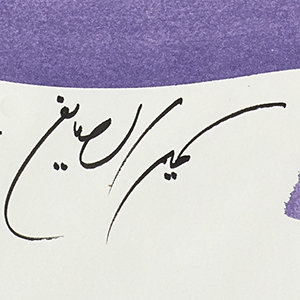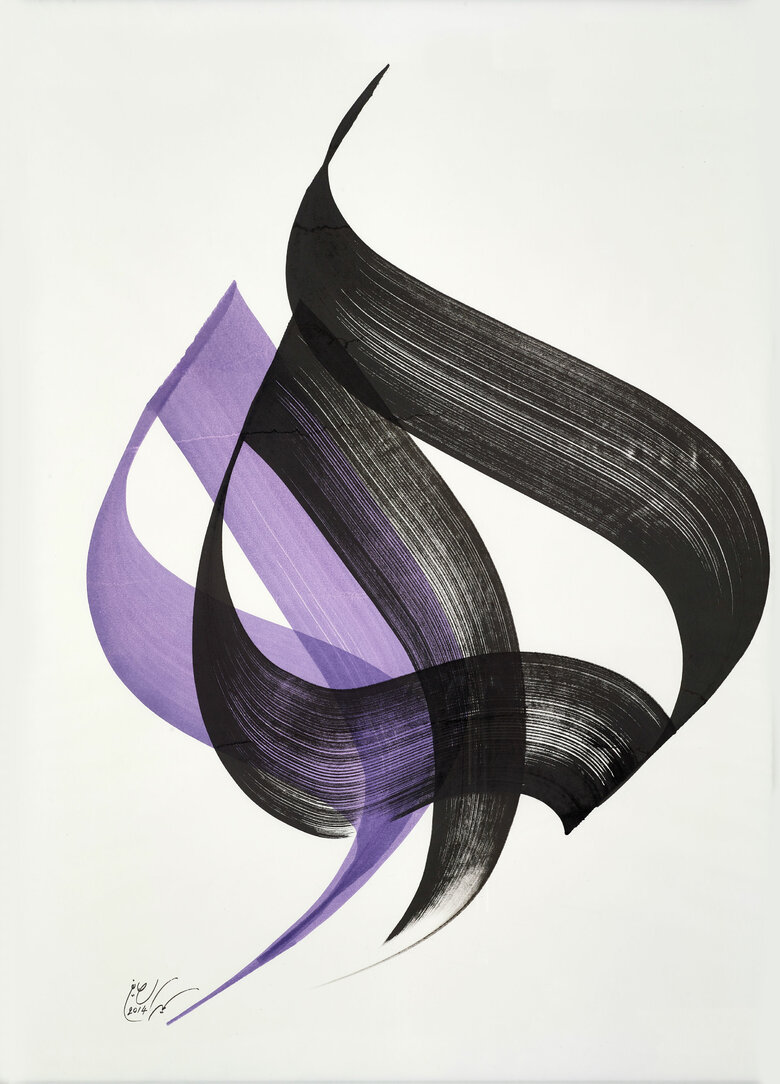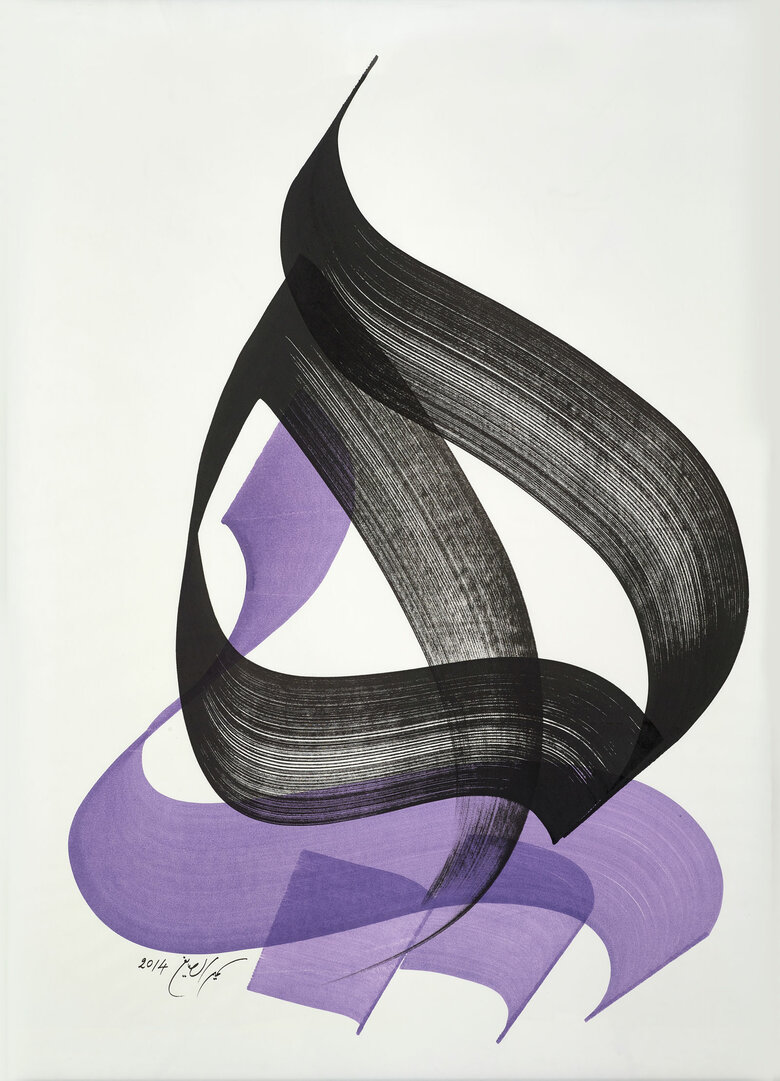Born in Beirut, in 19451, Samir Sayegh is considered a prolific critic, author, poet, and visual artist. Sayegh’s first encounter with calligraphy was when he was 12 years old, when his calligraphy...


SAMIR SAYEGH, Lebanon (1945)
Bio
Written by LIAM SIBAI
Born in Beirut, in 19451, Samir Sayegh is considered a prolific critic, author, poet, and visual artist. Sayegh’s first encounter with calligraphy was when he was 12 years old, when his calligraphy teacher informed him that he had beautiful handwriting2. His journey in calligraphy continued with his studies at the Saint Savior Convent in Joun, Lebanon3, an institution with an extensive collection of rare and ancient Arabic books4. By granting him access to these texts, the monastery helped Sayegh cultivate a deep appreciation for calligraphy. This appreciation of the visual aspect of language led him to pursue an art history degree from the Ecole des Beaux-Arts in Paris.
Sayegh’s formal education in the visual arts and his vast experience in writing set him up for a career as an art critic. After returning from Paris, he began writing for several renowned newspapers and journals in the Middle East, such as Lissan Al-Hal newspaper and Finoun Arabia, particularly from age 23 till the age of 35. This legitimacy gained through critical publication helped the young writer publish his first book of poems Maqam al-Qaws wa Ahwal Al-Sahm in 1980. In this period of the early 1980s, Sayegh also held his first exhibition of calligraphic works at Galerie Alisar, in Beirut. While consistently holding such exhibitions and writing works of criticism throughout the 1980s, he worked on a book about Islamic aesthetics, titled Islamic Art: A Reading into its Philosophy and Aesthetic, eventually publishing it in 1988.
In 1991, Sayegh became a member of the Sursock Art Museum Jury, a duty which he still serves, establishing him as a robust and important figure in the Lebanese cultural and intellectual spheres. Two years later, this robustness was further reinforced when he became a lecturer at the American University of Beirut's graphic design department.
Graphic design plays a unique role in Sayegh’s oeuvre and general conception of calligraphy. It is emblematic of both his relationship with form and his relationship to history, respectively. Graphic design is a practical medium, attempting to communicate ideas clearly through an aesthetic pleasing visual means5. Sayegh, however, does not believe that calligraphy, an essential component of graphic design6, can improve comprehension of language or the clarity of the content that language presents. Sayegh sees calligraphy as a purely aesthetic visual art7. More specifically, he views his work as a retinal aestheticization of language, as occurring in the eye, rather than in thought. He explains,
“There is an art which is conceived by the mind, and there is an art which is conceived by the eye. Calligraphy is for the eye”.
This primacy of form over content also explains Sayegh’s use of subject matter. He seems to select simple expressive words. The two works Houwa, 2014 and Hiya, 2014, part of the Ramzi and Saeda Dalloul Art Foundation (DAF), represent two very basic and core words in the Arabic language that mean “he” and “her”, respectively. The pieces are dominated by sweeping, bold black and soft lavender strokes that form fluid, ribbon-like shapes against a stark white background. Sayegh’s strokes applied with a wooden calligraphy pen, vary in thickness and intensity, reflecting the alternating pressure of the artist’s hand. Nonetheless, the focus is on a simple calligraphic word. This is a tendency that exists in his work in other pieces like Hob, 2016, which means love, or Ya2 Alef, 2014, which is named after two similar-looking letters in the Arabic language. Sayegh’s art is more about exhibiting the different manners of calligraphy. The blander the content of the writing, the more focus is placed on the style, and the more the form is able to take center stage, as previously mentioned.
Sayegh’s work occurs in a space of tension between the past and the present, between modernity and tradition8. He considers the profession of the modern graphic designer as an evolution of the disappeared profession of the type designer, who would inscribe newspaper fonts by hand. In the same breath, he has referred to his work as the return to a tradition of Arabic calligraphy, and as a modernization of that very tradition. He is just as obsessed with classical ways of producing calligraphy, even those of ancient Japan and China9, as he is with breaking their established rules of the practice.
This idea of breaking pre-existing rules of calligraphy in the second half of the 20th century was a staple of the principles of the Hurufiyya movement10 – an artistic movement that sought to integrate traditional Islamic calligraphy with contemporary abstract art forms. It emerged among Arab artists such as Ibrahim El-Salahi, Nasser Assar, and to an extent Samir Sayegh11, though he kept his distance from it as well12. These artists, particularly Sayegh, were just as influenced by Quranic and Kufic script, as they were by modern art.
One can see the influence of modern art by the extent to which Sayegh’s letters are abstracted, almost beyond recognition. Abstraction is one of modern art’s central tendencies, and Sayegh makes full use of it, as articulated by philosopher Nader El-Bizri13. This abstraction comes in spite of the fact that Sayegh’s letters are well-defined 14 and differentiated from their often-monochromatic background. This results from Sayegh’s technical method which involves using giant, felt-wrapped pens, some as large as 35 cm, to draw wide acrylic or ink lines on paper or fabric. The result is a collection of strong, dynamic letters.
Sayegh’s dynamic lettering, simplicity, and unique relationship with modernity mark him as a visionary artist, who both preserved a tradition and pushed it forward. Today, Samir Sayegh resides and works in Beirut, a city that has witnessed his unwavering commitment to reshaping the boundaries of calligraphy and modern Arab art.
Edited by Wafa Roz & Elsie Labban
Notes
1 “Samir Sayegh,” Atassi Foundation, accessed November 27, 2023, www.atassifoundation.com
2 Saleh Barakat, Encountering Samir Sayegh, other, Http://Muraqqa.Org/Samir-Sayegh.Html, 2009
3 “Samir Sayegh - Saleh Barakat,” Salehbarakatgallery.com, accessed November 26, 2023,
salehbarakatgallery.com
4 Jim and Jim, “The St. Saviour Monastery (Lebanon) Digitalization Project,” Zwinglius Redivivus, April 25, 2012, zwingliusredivivus
5 Gareth David, “Do Graphic Designers Need an Art Background?,” Gareth David Studio Blog, October 5, 2020, garethdavidstudio.co
6 “Calligraphy in Graphic Design,” John Stevens Calligraphy, April 8, 2020, johnstevensdesign
7 معرض الخط العربي للفنان سمير صايغ, YouTube (Future TV, 2014),
8 The New Epistles with Samir Sayegh, YouTube (Dar El-Nemir, 2021),
9 “Jordan National Gallery to Host Lebanese Artist Sayegh’s Solo Exhibition,” Jordan Times, March 6, 2023,
https://jordantimes.com/news/local/jordan-national-gallery-host-lebanese-artist-sayeghs-solo-exhibition#google_vignette/.
10 “Hurufiyya: Art & Identity,” Barjeel Art Foundation, November 12, 2017, https://www.barjeelartfoundatiom.com
11 “Hurufiyya Movement,” Academic Accelerator, accessed November 27, 2023, https://academic-accelerator.com
12 Saleh Barakat, Encountering Samir Sayegh, other, Http://Muraqqa.Org/Samir-Sayegh.Html, 2009.
13 Nader El-Bizri, The Art of Arabic Letters Symposium on the Oeuvres of Samir Sayegh (CENTER FOR ARAB &
MIDDLE EASTERN STUDIES, 2014).
14 Abigail Leali et al., “Samir Sayegh,” MutualArt, November 24, 2023, www.mutualart.com
Bibliography
Barakat, Saleh. Encountering Samir Sayegh. Other. Muraqqa.Org/Samir-Sayegh ,2009.
“Calligraphy in Graphic Design.” John Stevens Calligraphy, April 8, 2020. www.johnstevensdesign.com
David, Gareth. “Do Graphic Designers Need an Art Background?” Gareth David Studio
Blog, October 5, 2020. https://garethdavidstudio.com
El-Bizri, Nader. The Art of Arabic Letters Symposium on the oeuvres of Samir Sayegh. Center
For Arab & Middle Eastern Studies, 2014.
“Hurufiyya Movement.” Academic Accelerator. Accessed November 27, 2023. academic-accelerator.com
“Hurufiyya: Art & Identity.” Barjeel Art Foundation, November 12, 2017. www.barjeelartfoundati.org
Jim, and Jim. “The St. Saviour Monastery (Lebanon) Digitalization Project.” Zwinglius
Redivivus, April 25, 2012. zwingliusredivivus.wordpress.com
“Jordan National Gallery to Host Lebanese Artist Sayegh’s Solo Exhibition.” Jordan Times,
March 6, 2023. https://jordantimes.com/news/local/jordan-national-gallery-host-lebanese-artist-sayeghs-solo-exhibition#google_vignette.
“Jordan National Gallery to Host Lebanese Artist Sayegh’s Solo Exhibition.” Jordan Times, March 6, 2023. https://jordantimes.com/news/local/jordan-national-gallery-host-lebanese-artist-sayeghs-solo-exhibition#google_vignette.
Leali, Abigail, Michael Pearce, Adam Szymanski, and Benjamin Blake Evemy. “Samir Sayegh.” MutualArt, November 24, 2023. https://www.mutualart.com/
The New Epistles with Samir Sayegh. YouTube. Dar El-Nemir, 2021.
“Samir Sayegh - Saleh Barakat.” Salehbarakatgallery.com. Accessed November 26, 2023. http://salehbarakatgallery.com
“Samir Sayegh.” Atassi Foundation. Accessed November 27, 2023. https://www.atassifoundation.com/artists/samir-sayegh#:~:text=Born%20in%20Beirut%2C%20Samir%20Sayegh,Islamic%20art%20and%20Sufi%20poetry
Sayegh, Samir. “From The Beginning, I Sought To Liberate Calligraphy From Language.” | An Interview With Master Calligrapher Samir Sayegh. Other. Art Dubai, 2019.
Tate. “Abstract Art.” Tate. Accessed November 28, 2023. https://www.tate.org.uk/art/art-terms/a/abstract-art
“The Triumph of Form over Content.” The Free Library, 2014. https://www.thefreelibrary.com/The+triumph+of+form+over+content.-a0367981539.
معرض الخط العربي للفنان سمير صايغ. YouTube. Future TV, 2014.
CV
Selected Solo Exhibitions
2023
Samir Sayegh, Jordan National Gallery of Fine Arts, Amman, Jordan
2016
Bin Mater House, Manama, Bahrain
2015
Samir Al Sayegh, Dar Al Funoon, Kuwait
Aleph In Many Letters, Bin Matar House Art Space, Shaikh Ebrahim bin Mohammed Al Khalifa Center for Culture and Research, Bahrain
2014
Samir Sayegh, Agial Art Gallery, Beirut, Lebanon
2009
Agial Art Gallery, Beirut, Lebanon
2004
First Sharjah Biennale for Calligraphy, United Arab Emirates
2003
Agial Art Gallery, Beirut, Lebanon
1997
Galerie Atassi, Damascus, Syria
1996
Galerie 50 x 70, Beirut, Lebanon
1992
Galerie 50 x 70, Beirut, Lebanon
1988
Hariri Cultural Centre, Saida, Lebanon
1988
Goethe Insitut, Tripoli
1987
Kulturzentrum, Beirut, Lebanon
1983
Galerie Elissar, Beirut, Lebanon
Selected Group Exhibitions
2022
Hiya, Saleh Barakat Gallery, Beirut, Lebanon
2019
Out of Context, Saleh Barakat Gallery, Beirut, Lebanon
2018
Millenia of Creativity, NABU Museum, El Heri, Lebanon
Opening Remarks, Athr Gallery, Jeddah, Saudi Arabia
2016
Hurufiyya: Art & Identity, Barjeel Art Foundation, Sharjah, UAE
2014
Tariqah,Barjeel Art Foundation, Sharjah, UAE
2013
Strokes In Dialogue, Athr Gallery, Jeddah, Saudi Arabia
2012
Journey of the Line, Athr Gallery, Jeddah, Saudi Arabia
2011
Sharjah Biennial, United Arab Emirates
2006
Contemporary Arab Art, British Museum, London, United Kingdom
Selective Executive Works
Applied Works
Moucharrabieh of Omari Mosque, Beirut, Lebanon
Ceiling of Assila showroom, Jeddah, Saudi Arabia
Calligraphy for Books and Magazines
Center of Orthodox Studies, Al Namus Al Sharif, 1992
History of Banks in Lebanon.
Mediterranean Affairs magazine, Shu’un Al Awssat, 1997
Oriental Arts magazine, “Funun Sharqiah”
Selective Logos
Audi Institution, Saida, Lebanon
Soap Museum, Saida, Lebanon
Boutique Liwan, Paris, France
Mena Jet, Arab Airline Company
Syndicate of Engineers, Beirut and Tripoli, Lebanon
Beiteddine 27thFestival, Lebanon
The South for Construction Company, Lebanon
Publications
Samir Sayegh. الحروف و الكلمات. Plan Bey, Beirut, 2016.
Samir Sayegh. ما بعد. Plan Bey, Beirut, 2016.
Samir Sayegh. ألف بحروف كثيرة. Beirut, 2014.
Samir Sayegh. مذكرات الحروف. Beirut, 2003.
Samir Sayegh. Saloua Raouda Choucair: Her Life and Art.Beirut, 2002.
Samir Sayegh, Contemporary Art in Syria, 1998.
Samir Sayegh, Islamic Art: A Reading Into its Philosophy & Aesthetic Characteristics, 1988.
Samir Sayegh. مقام القوس و أحوال السّهم. Beirut, 1980.
Collections
Barjeel Art Foundation, Sharjah, UAE
Atassi Foundation, Dubai, UAE
Ramzi and Saeda Dalloul Art Foundation, Beirut, Lebanon
The British Museum, London, UK
Press
AlRai.pdf
Agenda Culturel.pdf
سمير الصايغ في غاليري أجيال الألف مكتوبةً بحروف كثيرة - ل. غ. - النهار.pdf
ABSTRACT CALLIGRAPHY_ LEBANESE AND JAPANESE ARTIST MEET.pdf
Samir Sayegh_Bien au-delà de l’écriture - C.H._L_Orient-Le Jour_Press.pdf
SamirSayegh_EncounteringSamirSayegh_Muraqqa_Press.pdf
صحيفة تشرين • طباعة مقال.pdf
رحلة في عالم الحرف العربي للفنان سمير صايغ.pdf
سمير الصايغ_ جلسة ذِكِر مع الحروف.pdf
سمير الصايغ لـ «الشرق الأوسط»_ أسيء فهم الزخرفة في الفن الإسلامي من قبل الشرق والغرب,.pdf
Al Jarida.pdf
طباعة - سمير الصايغ.. كلّما اتسع الخط ضاقت العبارة.pdf
أحمد بزّون سمير الصايغ_ الحروفيون يجهلون فن الخط _ ثقافة جريدة السفير.pdf
AL Arab p17.pdf
سمير الصايغ الطريق إلى «ما بعد الكتابة».pdf
Samir Sayegh_La lettre infinite_L_oritenLitteraire_Press.pdf
المدن - سمير الصايغ.. في البدء كان حرف الألف.pdf
الحياة - سمير الصايغ في رحلة الحروف السرية.pdf
سمير صايغ يطرق أبواب قصر بيت الدين - المجلة.pdf
SamirSayegh_“Alef in many letters” Shou Raeyak_Press.pdf
Samir Sayegh_ Agenda Culturel_Press.pdf
SamirSayegh_Calligraphy exhibition in Bahrain_Press.pdf
الفنانون - مؤسسة الشارقة للفنون.pdf
SamirSayegh_Exhibition Samir Sayegh_ Lebanon Art Magazine_Press.pdf
Samir Sayegh_Elias Khoury.pdf
SAMIR SAYEGH Artwork
Become a Member
Join us in our endless discovery of modern and contemporary Arab art
Become a Member
Get updates from DAF
Follow Artists
Save your favourite Artworks
Share your perspectives on Artworks
Be part of our community
It's Free!
We value your privacy
TermsCookiesPrivacy Policies
Become a Member
Get updates from DAF
Follow Artists
Save your favourite Artworks
Share your perspectives on Artworks
Be part of our community
It's Free!
We value your privacy
TermsCookiesPrivacy Policies
Become a Member
Get updates from DAF
Follow Artists
Save your favourite Artworks
Share your perspectives on Artworks
Be part of our community
It's Free!
We value your privacy
TermsCookiesPrivacy Policies
Welcome to the Dalloul Art Foundation
Thank you for joining our community
If you have entered your email to become a member of the Dalloul Art Foundation, please click the button below to confirm your email and agree to our Terms, Cookie & Privacy policies.
We value your privacy, see how
Become a Member
Get updates from DAF
Follow Artists
Save your favourite Artworks
Share your perspectives on Artworks
Be part of our community
It's Free!
We value your privacy
TermsCookiesPrivacy Policies






